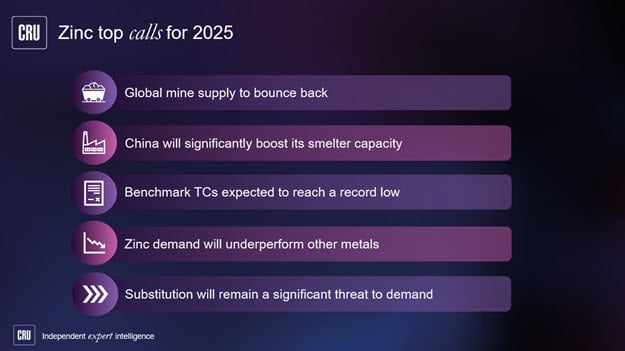The next generation of zinc mines are ready to supply but are smelters able to treat all the concentrate? Indeed, a bottleneck on the smelting side underpins our view of rising concentrate inventories over the next few years, resulting in higher treatment charges.
While our base case no longer has smelter output constrained enough to meet only modest demand growth. In this Insight, we look at a 2% change to our base case Chinese smelter utilisation rates and what that may mean for the global zinc metal and concentrates markets.
Chinese smelter output surged in 2017 Q4
A major surprise in 2017 Q4 was the record Chinese quarterly smelter output figures. Smelter output totalled 1.68 million tonnes (an outright record and up by 5% year-on-year) implying very high utilisation (near 100%) for a brief period. What made this result more impressive was the backdrop of critical levels of concentrate inventories and record low spot TCs.
While this result undoubtedly reflected smelters resuming operations after maintenance and feed-related closures earlier in 2017, it also reflected an increase of secondary oxides and dusts into the feed mix, supporting higher utilisation rates during the quarter. Below we have a brief look at the sensitivities of the global market to Chinese smelter utilisation and what a 2% gain or loss in utilisation may mean for the market in terms of the market balance and prices.
Before applying such scenarios, it is worth noting that through our historical series, 94% has been the effective cap on China’s average smelter capacity utilisation, and even this figure has been impossible to maintain for more than 9-12 months. Over longer periods, 91.5-92% has been an effective peak. But it is also interesting that over the past decade, the average share of large smelters (> 60,000 t/y) has gradually risen and there has been a decline in share for both medium (20-60 kt/y) and small (<20,000 t/y) smelters.
Chinese nameplate and effective capacities
For our Chinese par (or effective) capacity forecasts CRU takes two approaches to discount the nameplate capacity forecasts. Firstly, stated nameplate capacities for large smelters (>60,000 t/y) are applied whilst 75-80% of nameplate capacity for small (<20,000 t/y) and medium (20-60 kt/y) sized smelters is factored in. This difference we allocate as overstatement in our Chinese projections.
Secondly, we add a further slippage allowance to our numbers which factors expectations of slower than planned ramp up of expansions and new smelters in the pipeline. The net effect is that the nameplate capacity projections for Chinese smelters are 8.97 million tonnes by 2022, which is 1.2 million tonnes higher than our par capacity forecasts of 7.8 million tonnes. Therefore, if potential output were modelled based on nameplate capacity alone, implied utilisation rates in China would be lower than our series suggests.
Scenario downside and upside risks
Our base case is that Chinese smelter utilisation rates are expected to average 92.2% over our five-year forecast period.
Smelter utilisation 2% lower than our base case - If smelter utilisation were 2% lower than our base case forecast (i.e. 90.2% average between 2018-2022) the zinc market would swing more strongly in favour of smelters.
- Adjusted global cumulative concentrate inventories could reach close to 3.2 million tonnes by 2022, representing over 700,000 tonnes more than in our base case scenario. This result would underpin significantly stronger rises in TCs over our forecast period.
- This, in turn, could mean that the metal market switches to balance rather than to surplus in 2019-2021, although it would still move into surplus by 2022.
- Zinc prices would find more support as a smelting bottleneck would somewhat cap metal availability until 2021 (a large concentrate surplus would emerge), with prices falling perhaps only to $2,580/t in real terms by 2022.
Smelter utilisation 2% higher than our base case - If smelter utilisation were 2% higher than our base case forecast (i.e. 94.2% average between 2018-2022), concentrate market surpluses would be more modest, but large metal market surpluses would emerge.
- Adjusted global cumulative concentrate inventories would reach 1.7 million tonnes by 2022, around 700,000 tonnes less than in our base case scenario. This would underpin more moderate, although still strong, gains in TCs over the forecast.
- It would also tip the metal market into a substantial surplus, with some 1.4 million tonnes of metal surpluses building by 2022.
- In this scenario, zinc’s price would need to fall toward the 50th centile of the CRU Cash Cost curve in order to bring about supply discipline and prices could fall as low as $1,675/t in real terms by 2022.
As small- to medium-sized smelters adapt to stricter environmental regulations there are two potential outcomes: i) further closures of small and relatively dirty smelters (we have seen numerous examples of small smelter closures over the past few years) and/or ii) expansion and modernisation plans to increase capacity and improve efficiency. Across the population both these outcomes would drive higher utilisation rates, although the former would of course remove nameplate capacity – albeit with a declining effect as the market share of small- to medium-scale smelters in China is already declining.
An excellent example of efficiency gains was seen over the past few years at Yunnan Copper’s zinc smelters in Kunming and Maguan. Rather than carry out detailed expansion projects, the company expanded existing capacity slowly through technology improvements. The Kunming-based zinc smelter capacity reached 110,000t by late 2017, up from 66,000 t/y in 2011. Capacity at its Maguan zinc smelter increased to 60,000 t/y from 30,000 t/y in 2013. We expect this kind of reform to be important in driving further consolidation and average capacity growth in the Chinese smelting sector and this could ultimately support higher utilisation rates than seen in the past.

















